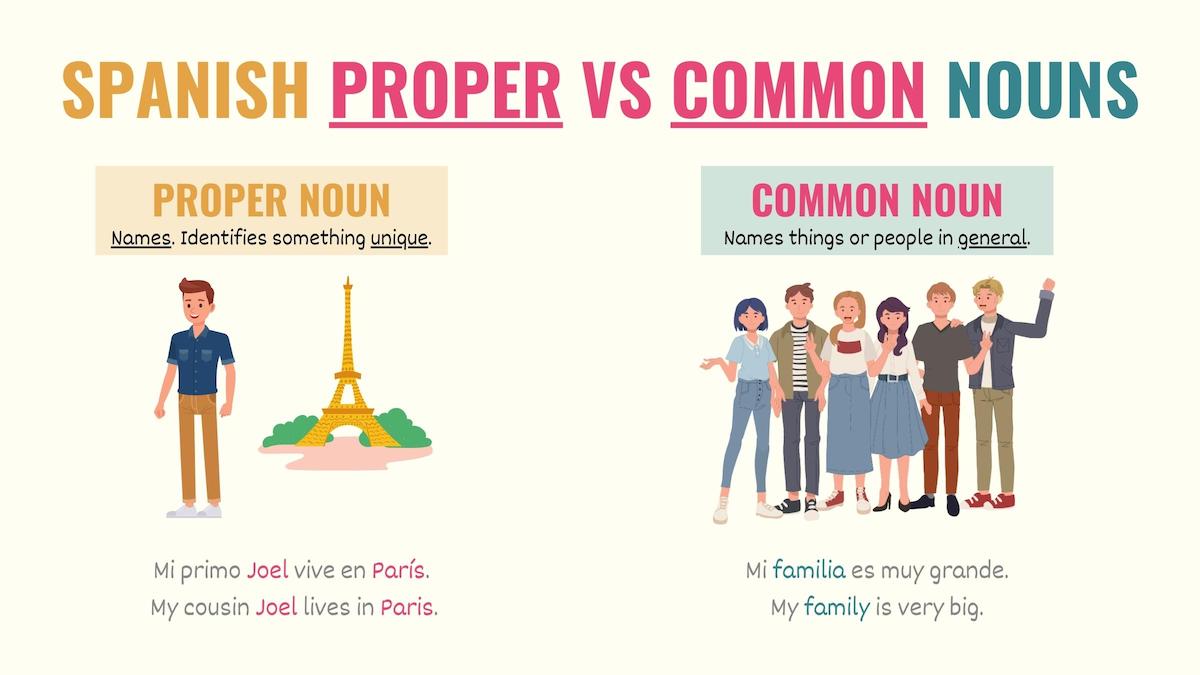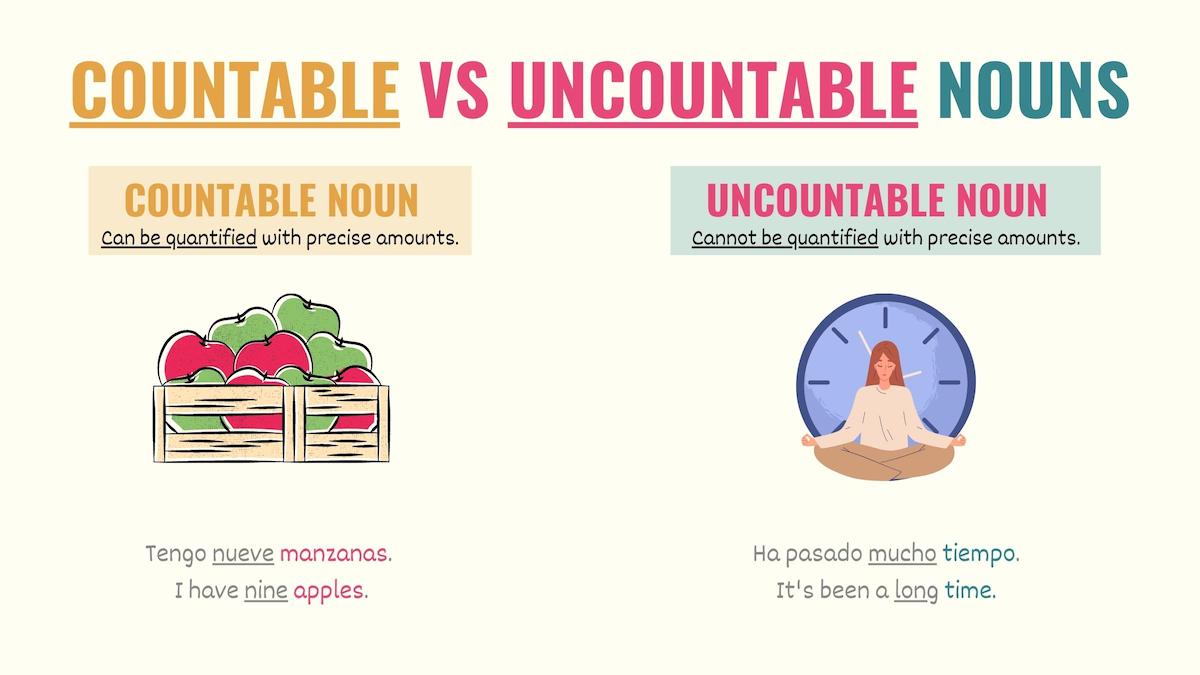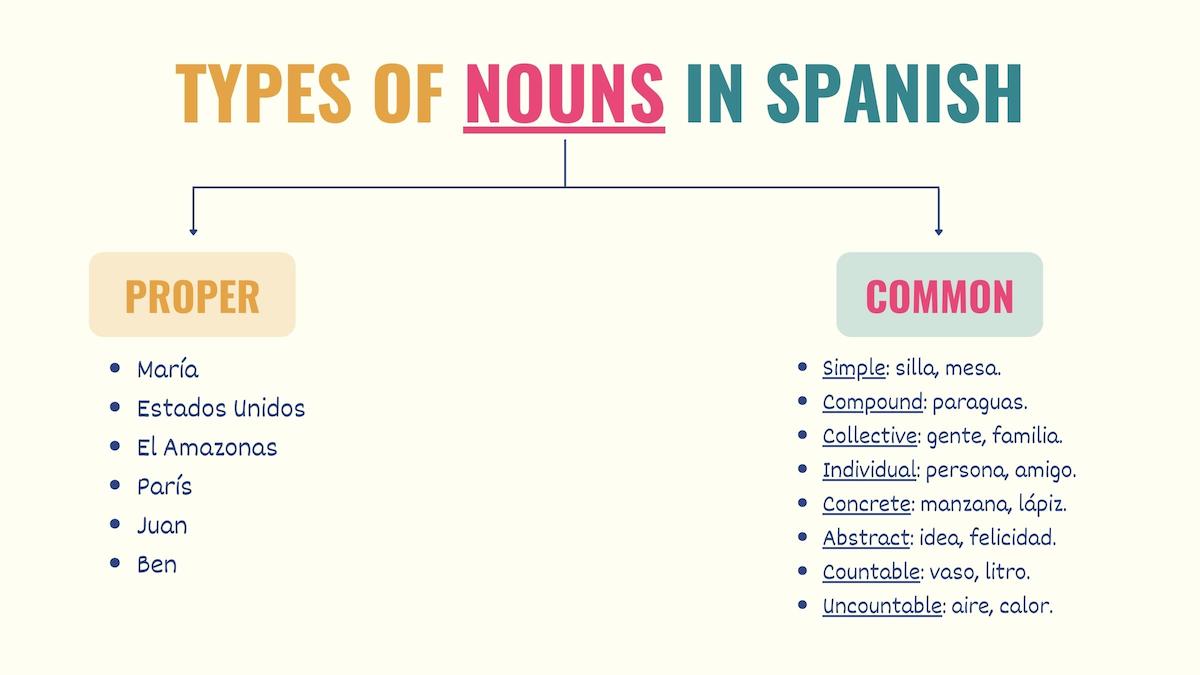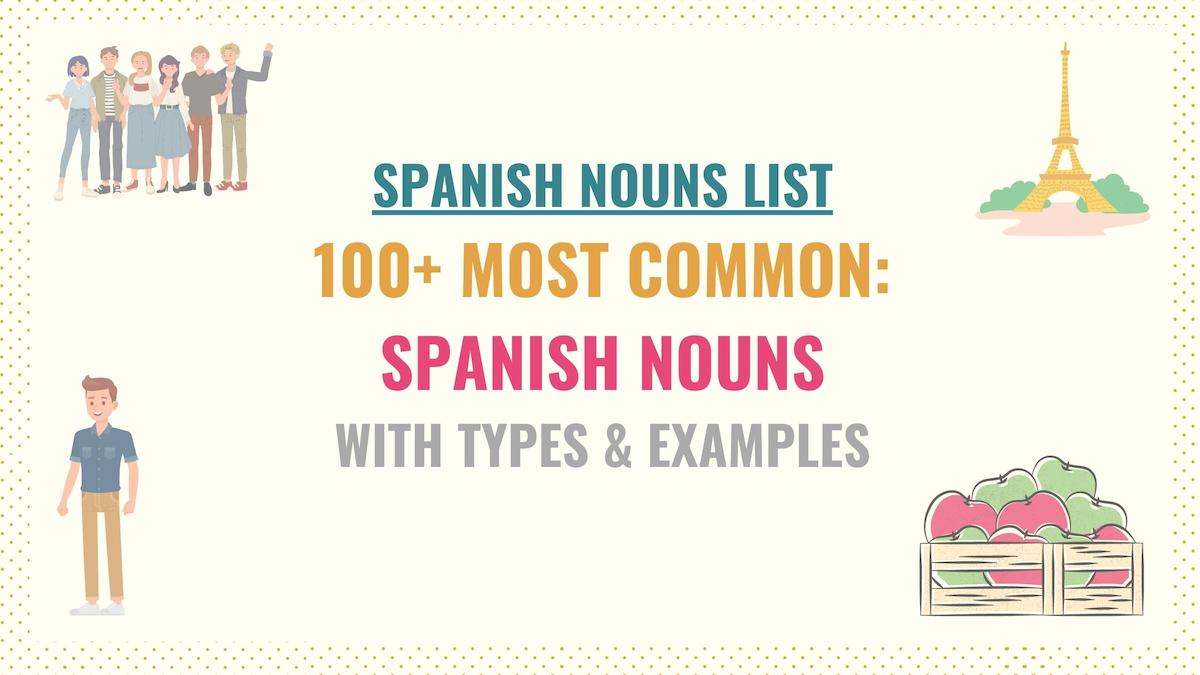Nouns are the type of words that name things, people, places, or concepts. Simply put, these words are crucial for forming sentences. So, in this guide, I’ve compiled a list of the most common nouns in Spanish. Here is an overview of what we’ll cover:
- Proper Nouns
- Common Nouns
- List of Must-Know Nouns
- Key Points
- Download the Spanish Nouns Cheat Sheet PDF
- Additional Resources
Spanish nouns can be classified into two primary categories: proper and common. In the sections below, I’ll provide you with examples and descriptions so you understand the difference between them.
Take Note: Do not confuse nouns with Spanish pronouns. Pronouns replace a noun and, sometimes, indicate the relationship between that word and the subject, such as possession. There’s no such thing as direct object nouns or possessive nouns. In this case, we’re referring to pronouns.
Proper Nouns
Spanish proper nouns are commonly known as names. As a result, they’re often used to name unique people, cities, countries, rivers, mountains, seas, or art pieces. Some examples of proper nouns are:
- Andrea
- Argentina
- Beatrice
- Canadá
- El Paso
- La Mona Lisa
- Monte Everest
- París
According to the capitalization rules in Spanish, you must always capitalize the first letter of a proper noun. Also, these types of nouns don’t work with definite articles (el, la, los, las) unless such terms are part of the name.
Check these sentences:
Carolina es de El Paso.
Carolina is from El Paso.
Tu hermana y Juan fueron a España.
Your sister and Juan went to Spain.
Cuando fuimos a París, visitamos el Louvre.
When we went to Paris, we visited the Louvre.
Take Note: In Spanish, nicknames for given names are also treated as proper nouns.
Common Nouns
In Spanish, we use common nouns to name or identify people, places, animals, and things in general.

Take Note: You should only capitalize common nouns if they start the sentence. Additionally, these words are always preceded by a determiner, such as definite articles, possessives or demonstratives.
Depending on their characteristics, common nouns are classified into:
Simple & Compound
In Spanish, a compound noun is formed by two words (another noun, verb, or adjective). For example:
- Abrelatas: Can opener
- Arcoiris: Rainbow
- Lavavajillas: Dishwasher
- Paraguas: Umbrella
- Rompecabezas: Puzzle
- Sacapuntas: Pencil sharpener
On the other hand, simple nouns are single terms, such as:
- Bolsa: Bag
- Ciudad: City
- Escuela: School
- Hermano: Brother
- Pluma: Pen
Here are some examples:
Esta bolsa es de Diana.
This bag is Diana’s.
Dejé el paraguas en el taxi.
I left the umbrella in the taxi.
Los abrelatas están en la mesa.
The can openers are on the table.
Mi hermano olvidó su sacapuntas.
My brother forgot his pencil sharpener.
Take Note: For the most part, compound words are masculine nouns. Additionally, if they already end in ‘-s’ and you need to use them as plural words, you must use a plural determiner to mark the number (example #2).
Collective & Individual
Spanish collective nouns refer to a group of people, animals, or things. For example:
- Equipo: Team
- Familia: Family
- Gente: People
- Vajilla: Dinnerware
On the other hand, individual nouns refer to single things. For instance:
- Amigo: friend
- Persona: person
- Plato: plate
Except for gente, collective and individual nouns can have a singular or plural form. Check the sentences below:
El plato blanco es mío.
The white plate is mine.
Hay muchas familias en esta colonia.
In this neighborhood, there are a lot of families.
A muchas personas les gusta el chocolate.
Many people like chocolate.
Concrete vs Abstract nouns
In Spanish, a concrete noun refers to material things we perceive with the five senses. For example:
- Manzana: Apple
- Niño: Boy
- Libro: Book
- Perro: Dog
- Vaso: Cup
Unlike concrete words, abstract nouns are not material things. Simply put, these nouns refer to concepts, feelings, or ideas:
- Amor: Love
- Emergencia: Emergency
- Hambre: Hunger
- Idea: Idea
- Opinión: Opinion
Here are some sentences using these words:
La idea de Jesús es muy interesante.
Jesus’s idea is very interesting.
Me comí tu manzana.
I ate your apple.
Su opinión es importante.
Your opinion is important.
El niño tiene hambre.
The boy is hungry.
Countable & Uncountable

In Spanish, a countable noun refers to things you can quantify with precise amounts. You can use numbers or adjectives to provide this information. Examples of countable Spanish nouns are:
- Almohada: Pillow
- Carro: Car
- Gato: Cat
- Lápiz: Pencil
- Plátano: Banana
As its name suggests, uncountable nouns identify things we cannot quantify with numbers. For example:
- Arroz: Rice
- Clima: Weather
- Dinero: Money
- Música: Music
- Leche: Milk
- Tiempo: Time
Here are some sentences using these words:
Me gusta la música.
I like music.
Quiero un litro de leche.
I want a liter of milk.
Nos comimos todo el arroz.
We ate all the rice.
Hay dos plátanos en la mesa.
There are two bananas on the table.
Notice that, with uncountable food nouns (such as leche), you can provide exact amounts if your sentence includes a countable noun like litro.
List of Common Nouns in Spanish
The Spanish nouns list below contains the most basic nouns you must know as a Spanish beginner.
Feminine nouns
- Abuela: Grandmother
- Agua: Water
- Basura: Garbage
- Biblioteca: Library
- Bicicleta: Bike
- Boca: Mouth
- Bolsa: Bag
- Botella: Bottle
- Cabeza: Head
- Cama: Bed
- Canción: Song
- Calle: Street
- Casa: House
- Ciudad: City
- Cena: Dinner
- Comida: Food
- Computadora: Computer
- Cuchara: Spoon
- Escuela: School
- Espalda: Back
- Familia: Family
- Fiesta: Party
- Flor: Flower
- Fruta: Fruit
- Gente: People
- Hambre: Hunger
- Hora: Hour / Time
- Mamá: Mom
- Maestra: Teacher
- Maleta: Suitcase
- Mano: Hand
- Mesa: Table
- Mochila: Backpack
- Música: Music
- Niña: Girl
- Noche: Night
- Leche: Milk
- Llave: Key
- Pared: Wall
- Película: Movie
- Pluma: Pen
- Puerta: Door
- Ropa: Clothes
- Silla: Chair
- Taza: Cup
- Televisión: TV
Masculine nouns
- Abuelo: Grandpa
- Aeropuerto: Airport
- Aire: Air
- Amor: Love
- Animal: Animal
- Árbol: Tree
- Arroz: Rice
- Avión: Airplane
- Banco: Bank
- Baño: Toilet
- Bote: Boat / Can
- Brazo: Arm
- Día: Day
- Dedo: Finger
- Café: Coffee
- Camión: Bus
- Calor: Heat
- Carro: Car
- Chocolate: Chocolate
- Cielo: Sky
- Clima: Weather
- Color: Color
- Cuaderno: Notebook
- Cuchillo: Knife
- Diente: Tooth
- Dinero: Money
- Doctor: Doctor
- Dolor: Pain
- Helado: Ice cream
- Hotel: Hotel
- Huevo: Egg
- Escritorio: Desk
- Frío: Cold
- Jabón: Soap
- Jamón: Ham
- Jugo: Juice
- Mapa: Map
- Mar: Sea
- Niño: Boy
- Número: Number
- Lápiz: Pencil
- Libro: Book
- Pan: Bread
- Papá: Dad
- Perro: Dog
- Pie: Foot
- Plátano: Banana
- Problema: Problem
- Puente: Bridge
- Reloj: Clock / Watch
- Restaurante: Restaurant
- Sol: Sun
- Sillón: Sofa
- Supermercado: Supermarket
- Té: Tea
- Tenedor: Fork
- Teléfono: Phone
- Tiempo: Time
- Trabajo: Job
- Tren: Train
- Vaso: Cup
- Video: Video
- Vino: Wine
- Zapato: Shoe
Take Note: In Spanish, sustantivos is the word for ‘nouns’, whereas nombres propios is the translation of proper nouns.
Key Points
Here are some essential things to remember about nouns:
- A noun is used to name or identify people, concepts, places or things.
- Spanish nouns can be classified into:
- Proper: these are commonly known as names and refer to specific and unique things.
- Common: these are the words we use to name things in general.
- In turn, common nouns can be:
- Simple if they’re formed with one term or compound if they’re formed with two words (a noun, adjective, or verb).
- Countable or uncountable depending on how easy it’s to quantify them.
- Concrete or abstract depending on whether they refer to material or immaterial things.
- Individual if they refer to a single element or collective if they encompass a group of people, animals or things.

Download the Spanish Nouns Cheat Sheet & List PDF
Nouns are fundamental Spanish words you must continue learning in order to achieve your goals of becoming conversational or fluent in this language. To help you improve your Spanish vocabulary, I’ve compiled cheat sheets for this guide into a PDF with all the Spanish nouns above as well as their key types.
Additional Resources & Lists for Learning Spanish Nouns
If you want to improve your command of nouns in Spanish, you must also understand how the rules of gender (determining when a Spanish noun is feminine) and number (plural forms) work. Additionally, because they work together with these words, you should get familiar with Spanish determiners.
Here are some specific lists of nouns that you can check to improve your vocabulary:



